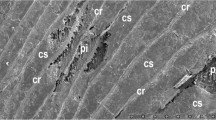Abstract
Recent investigations (1984) on the biology and morphometry of populations of the edible sea-urchinParacentrotus lividus (Lamarck) exposed to massive domestic pollution from the Cortiou sewage outlet (Marseille, France), revealed a significant lengthening of sea-urchin spines at sites located at a distance of 500m (Station 0) and 1 200 m (Station 1) from the outlet. At Station 0, spine length (SL) is nearly half as long as the diameter (D) of the test, resulting in a higher SL:D ratio here-0.470 as opposed to 0.360 in unpolluted areas (e.g. Station 3, 5 200 m from the outlet). This spine lengthening appears to be a morphofunctional adaptation, enabling the sea-urchins to adopt sestonophagy in order to benefit better from the plentiful resources of both particulate and dissolved organic matter arising from the outfall; examination of pellets filling the stomachs and guts of the sea-urchins corroborated this. SEM examination revealed that spines of specimens collected at Station 0 are more “porous” than those from Station 3 and their microarchitecture is better adapted to capturing suspended particulate matter: the ridges are narrower, the grooves wider, and the latter display a dense and more coarsely-meshed network. The axial medulla exhibits true and regularly arranged channels with highly structured walls. The ratio dry wt of spine: dry wt of test revealed thatP. lividus spines from Station 0 (ratio= 1.2) are lighter than those from Station 3 (ratio=1.4), reflecting the more porous microstructure and lighter stereome of the Station 0 sea-urchins. Previous measurements to determine the degree of eutrophication in the area polluted by the Marseilles urban sewage outfall revealed carbon content, as % of total sediment, as high as 36% in newly deposited sediment (100 m from the outlet), 16.7% at Station 0 (500 m) and 2.6% near Station 3 (about 5 200 m). Further experiments using sediment traps indicated that the organic matter tends to accumulate chiefly along the shoreline, whereas the suspended mineral fraction tends to be deposited to the south, i.e., further offshore. Thus, theP. lividus population at Station 0 exhibits a very unusual ecological plasticity, having developed a very efficient adaptative microstructure in order to meet its energy requirements despite the presence of various chemical pollutants.
Similar content being viewed by others
Littérature citée
Bellan, G., D. Bellan-Santini et J. Picard: Mise en évidence de modèles éco-biologiques dans des zones soumises à perturbations par matières organiques. Oceanol. Acta3(3), 383–390 (1980)
Bourcier, M.: Contribution à la connaissance des sédiments marins entre le cap Croisette et le cap d'Alon (Est de Marseille) et de leur évolution de 1966 à 1972. Téthys9(1), 31–40 (1979)
Caruelle, F.: Pollution marine de surface par les détergents anioniques provenant des égouts de Marseille, 87 pp. Thèse Doctorat, Faculté Pharmacie, Marseille, France 1973
Daumas, R., S. Garlenc, P. Laborde et J. C. Romano: Etude d'une aire côtière soumise à une pollution globale d'origine urbaine. Rapport Biochimie, convention Ville de Marseille 80–240, convention Ministère de l'Environnement 80.009 (1980) (Données non publiées, à diffusion limitée)
De Burgh, M. E., A. B. West and F. Jeal: Absorption of L-alanine and other dissolved nutrients by the spines ofParacentrotus lividus (Echinoidea). J. mar. biol. Ass. U.K.57, 1031–1045 (1977)
Delmas, P. et M. B. Régis: Impact de la pollution domestique sur la biologie et la morphométrie de l'EchinoïdeParacentrotus lividus (Lamarck). Données préliminaires. C.r. hebd. Séanc. Acad. Sci., Paris300 (4), 143–146 (1985a)
Delmas, P. et M. B. Régis: Influence d'une pollution complexe à dominante domestique sur les populations de l'Echinoïde comestibleParacentrotus lividus (Lamarck). Vie mar.6, 63–72 (1985b). (Fondation océanographique Ricard, Marseille)
Delmas P. et M. B. Régis: Données préliminaires sur le contenu digestif de l'oursin comestibleParacentrotus lividus (Lamarck) soumis à l'influence des effluents domestiques. Mar. envirl Res. (Sous presse)
Harmelin, J. G., C. Bouchon et J. S. Hong: Impact de la pollution sur la distribution des échinodermes des substrats durs en Provence (Méditerranée nord-occidentale). Téthys10(1), 13–36 (1981)
Péquignat, E.: “Skin digestion” and epidermal absorption in irregular and regular urchins and their probable relation to the outflow of spherule-coelomocytes. Nature, Lond.210, 397–399 (1966)
Péquignat, E.: Sur l'absorption et l'utilisation de molécules dissoutes ainsi que des particules en suspension par les oursins réguliers et irréguliers. C.r. Séanc. Soc. Biol.163, 100–104 (1969)
Péquignat, E.: Some new data on skin-digestion and absorption in urchins and sea stars (Asterias andHenricia). Mar. Biol.12, 28–41 (1972)
Pérès, J. M.: Major benthic assemblages.In: Marine ecology, Vol. 5, Ocean management, Part 1. pp 373–522. Ed. by O. Kinne. Chichester: John Wiley & Sons 1982
Régis, M. B.: Premières données sur la croissance deParacentrotus lividus (Lmk). Téthys1 (4), 1949–1955 (1969)
Régis, M. B.: Croissance de deux échinoïdes du golfe de Marseille (Paracentrotus lividus (Lmk) etArbacia lixula L.). Aspects écologiques de la microstructure du squelette et de l'évolution des indices physiologiques, 221, pp. Thèse Doctorat èsSciences, Université d'Aix-Marseille III, France, 1978
Régis, M. B.: Particularités microstructurales du squelette deParacentrotus lividus etArbacia lixula: rapports avec l'écologie et l'éthologie de ces échinoïdes. Mar. Biol.54, 373–382 (1979)
Author information
Authors and Affiliations
Additional information
Communicated by J. M. Pérès, Marseille
Rights and permissions
About this article
Cite this article
Régis, M.B. Microstructure adaptative des radioles deParacentrotus lividus (Echinodermata: Echinoidea) en milieu eutrophisé par des eaux usées. Mar. Biol. 90, 271–277 (1986). https://doi.org/10.1007/BF00569138
Accepted:
Issue Date:
DOI: https://doi.org/10.1007/BF00569138




